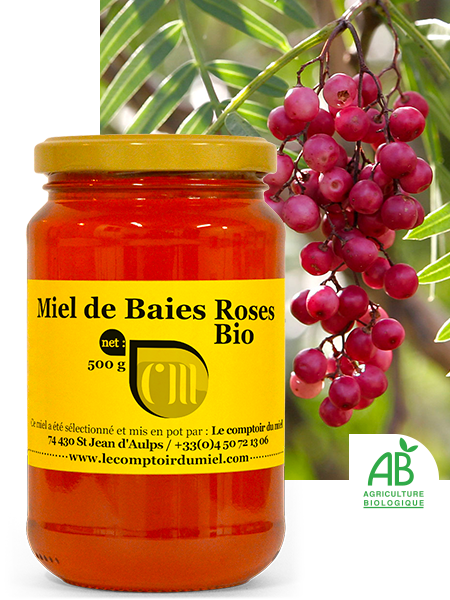Do you know pink berries?
From the false pepper tree, whose Latin name is schinus terebinthifolia raddi, these berries have a peppery taste. The tree can reach 6 to 10 meters in height.
The world’s leading producers of pink berries are Brazil and Madagascar. This is why, thanks to our powerful partnership with Madagascar, we can offer you this ORGANIC Pink Berry honey.
Originally from South America (Brazil), schinus terebinthifolia raddi is now exploited for its berries in other tropical regions, mainly Reunion Island and Madagascar. Madagascar is the main producer of pink berries. In some regions, notably the United States and New Caledonia, this species behaves like an invasive plant. In New Caledonia, it is forbidden to sell or simply harvest it!
Its berries give off a peppery or terebinth-like scent. The tree secretes a sap resinous sap, suggestive of turpentine, which turns blackish when exposed to air. This is where its botanical name terebinthifolia comes from.
The taste and flavour of ORGANIC pink berry honey:
Organic pink berry honey has a slightly astringent scent. Probably a reminder of the smell of berries. Its taste is slightly peppery. All this suggests that it has the same properties as the fruits and flowers from which it comes!
The properties and benefits of pink berries:
Pink berries have anti-inflammatory, antiseptic and antispasmodic properties. It helps relieve rheumatic and joint pain. It also helps cleanse the respiratory tract and is thought to act on digestive disorders. Pink pepper also has vasoconstrictor properties.
The tree itself is considered astringent, antibacterialdiuretic and digestive stimulant. It is also a tonic, antiviral and healing agent. In Peru, the sap is used as a mild laxative and diuretic. The whole plant is used externally for fractures and as a topical antiseptic. The oleoresin derived from the sap is used externally as a healingto stop bleeding and toothache, and internally for rheumatism and as a purgative.
In South Africa, a leaf tea is used to treat colds, and a leaf decoction is inhaled for colds, hypertension, depression and irregular heartbeat.
In the Brazilian Amazon, an infusion of bark is used as a laxative, while an infusion of bark and leaves is used as a stimulant and antidepressant.
In Argentina, a decoction is made from the dried leaves and is taken for menstrual disorders and is also used for infections and disorders of the respiratory and urinary tracts.
Pink berries in medicine :
Today, Brazilian pepper is still used in phytotherapy in many countries. In the tropics, it is used for a wide range of ailments, including menstrual disorders, bronchitis, gingivitis, gonorrhea, gout, eye infections and many others. Rheumatism, wounds, swellings, tuberculosis, ulcers and other infections can also be cured with this tree. Today, in Brazilian herbal medicine, dried bark or leaves are used to treat heart problems. Indeed, high blood pressure and irregular heartbeats can be cured with pink berries. In short, the Brazilian pepper plant is the ultimate bulwark against many infections!
Recently, the plant’s fruit has been studied and shown promise as a treatment for MRSA (methicillin-resistant Staphylococcus aureus). A chemical contained in the berry appears to prevent bacteria from producing a toxin that destroys tissue. It also seems to suppress the way bacteria communicate. Which is really promising!
In short, as you can see, pink berries enjoy a reputation that should not be overlooked.
Did you know?
This tree is considered invasive in many countries, including Brazil and New Caledonia. It is even used as a firebreak in Maré, New Caledonia.

Reviews
There are no reviews yet.